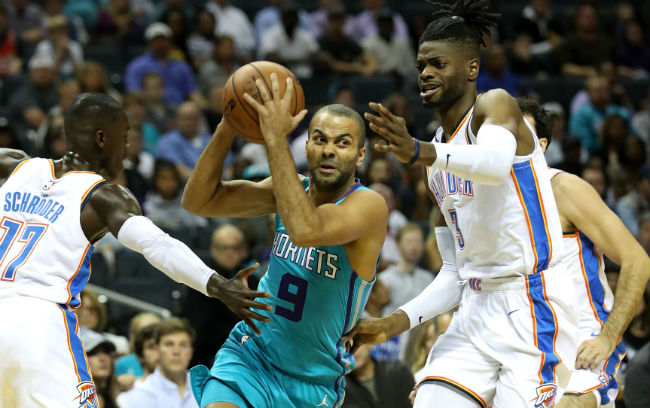
The Oklahoma City Thunder have historically built their roster with one archetype in mind: long, athletic players who may or may not (usually the latter) be able to shoot from distance. Therefore, while finding enough spacing around their offensive stars has always been a challenge, particularly in the postseason, the Thunder have hung their hat on defense.
That has been the case once again this year, as the Thunder sport a defensive rating of 103.2 (points allowed per 100 possessions), fourth in the league, per NBA.com. It’s also a sizable jump from last season, when OKC finished the year as the ninth best defense with a rating of 106.3. But that doesn’t tell the whole story.
Before Andre Roberson, one of the league’s premier perimeter defenders, injured his patella in January, the Thunder were an elite defense with a defensive rating of 104.7. The wheels fell off without Roberson, as they only managed an average rating of 108.7 in his absence. Given how Oklahoma City lauded Roberson as a Defensive Player of the Year candidate in his absence, it would stand to reason that the Thunder would continue to struggle as their wing stopper began the start of this season on the shelf.
And yet, 16 games into the season, OKC has had no difficulty without Roberson, which begs the question: what exactly are the Thunder doing better?
It starts with personnel. Last season, Oklahoma City was forced to rely on Carmelo Anthony and Alex Abrines to fill minutes on the wing. Now the team has more lanky players in the Thunder mold to fill those slots, namely Dennis Schroder, who was acquired in the Anthony trade during the offseason, and second-round pick Hamidou Diallo.
Schroder has been surprisingly effective after a disastrous stretch in Atlanta last year. Being on a winning team appears to have revitalized him and forced him to rediscover the defensive habits that made him such a promising young guard. Schroder has the length to disturb opposing players and be a deterrent in passing lanes, his small stature obscuring his long arms.
Diallo still has his rookie foibles and is jumpy on defense, but the tools are clearly there. He has a 6’11 wingspan, just like Paul George, and when the two play together, they make it very difficult for opponents to even pass the ball to one another. Diallo is also particularly adept at taking the ball away on drives, or when the offensive player is trying to move the ball in the paint.
George and Diallo both have steal percentages of 2.6 percent, which places them in the 96th percentile among wings per Cleaning the Glass. Active hands are common up and down the roster, as Russell Westbrook, Steven Adams, and Nerlens Noel all have among the top steal rates at their positions. It’s unsurprising that Oklahoma City leads the league with 11.1 steals per game and forces turnovers on 17.9 percent of opponent possessions, second only to Memphis.
Noel has been another strong defensive addition for the Thunder. His mobility allows him to cover a lot of ground on defense, forcing OKC opponents to shoot at least seven percent worse from every area of the court, except the rim, when Noel is on the floor. Even though Noel is a fairly lousy rim protector, the Thunder with Noel at center at least allow fewer shots at the rim, shading their opponents into the less-optimal floater range. His individual defensive rating is 98.0, easily the best mark of his career.
Even with their defense intact, the Thunder still haven’t solved their eternal crisis: finding players who can contribute on both offense and defense. Noel can’t do anything outside of the paint, which makes him essentially unplayable next to Adams; Schroder, while still capable of creating for others, is unable to generate anything as a scorer on the occasions he doesn’t turn the ball over himself; and Diallo is still a rookie who can finish plays, but there’s a reason he was available in the second round.
In that sense, the replacements mirror a lot of Roberson’s strengths and weaknesses. Oklahoma City has been able to reclaim its defensive identity by targeting the players its always has, building around athletes who can jump out of the gym and executive defensive schemes but lack the skill to produce consistently on the other end.
Once Roberson comes back, Billy Donovan will have some more toys to play with, and presumably much more pressure to apply to opposing offenses. Nothing has really changed systemically, but the Thunder have just found more players who play the way they’ve always wanted to.






